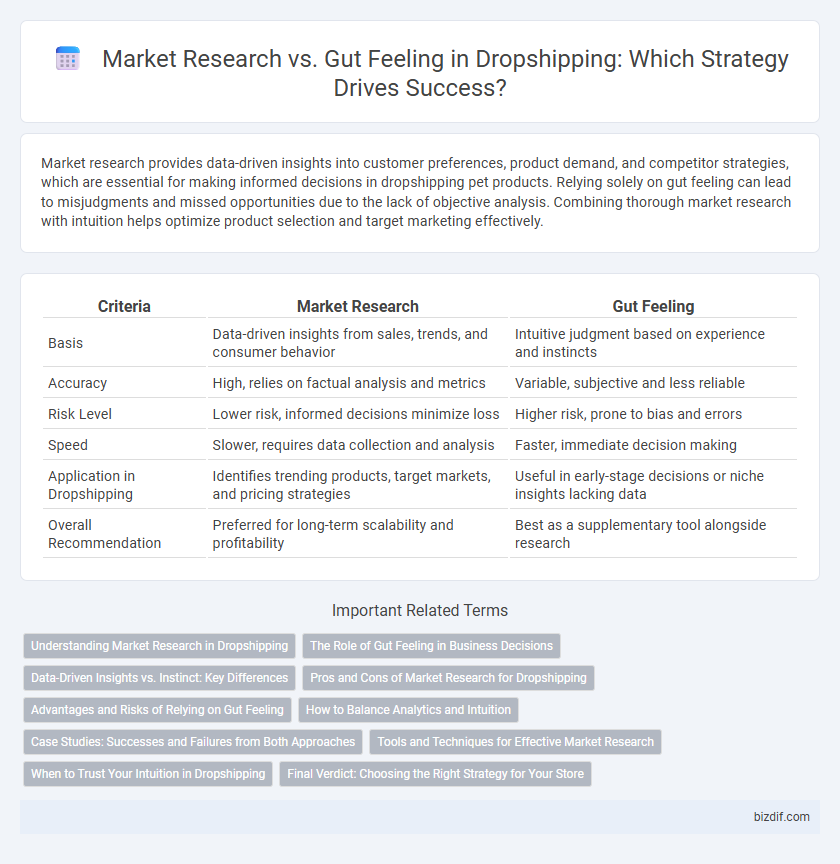Market research provides data-driven insights into customer preferences, product demand, and competitor strategies, which are essential for making informed decisions in dropshipping pet products. Relying solely on gut feeling can lead to misjudgments and missed opportunities due to the lack of objective analysis. Combining thorough market research with intuition helps optimize product selection and target marketing effectively.
Table of Comparison
| Criteria | Market Research | Gut Feeling |
|---|---|---|
| Basis | Data-driven insights from sales, trends, and consumer behavior | Intuitive judgment based on experience and instincts |
| Accuracy | High, relies on factual analysis and metrics | Variable, subjective and less reliable |
| Risk Level | Lower risk, informed decisions minimize loss | Higher risk, prone to bias and errors |
| Speed | Slower, requires data collection and analysis | Faster, immediate decision making |
| Application in Dropshipping | Identifies trending products, target markets, and pricing strategies | Useful in early-stage decisions or niche insights lacking data |
| Overall Recommendation | Preferred for long-term scalability and profitability | Best as a supplementary tool alongside research |
Understanding Market Research in Dropshipping
Market research in dropshipping involves analyzing consumer behavior, competitor strategies, and trending products to make data-driven decisions that minimize risks and maximize profitability. Utilizing tools such as Google Trends, social media analytics, and niche-specific forums helps identify demand patterns and target customer preferences effectively. This empirical approach outperforms gut feeling by providing actionable insights that optimize product selection and marketing strategies.
The Role of Gut Feeling in Business Decisions
Gut feeling plays a critical role in dropshipping business decisions by leveraging entrepreneurial intuition to identify emerging trends and customer preferences before they appear in data. Experienced dropshippers often integrate instinct with market research to balance quantitative insights with qualitative judgment, enhancing responsiveness and innovation. This intuitive approach can accelerate decision-making, especially in fast-moving e-commerce markets where data may be lagging or incomplete.
Data-Driven Insights vs. Instinct: Key Differences
Market research relies on data-driven insights, utilizing customer behavior analytics, sales trends, and competitor performance to inform dropshipping decisions. Gut feeling depends on instinct and personal experience, often lacking quantifiable evidence but allowing rapid decision-making in uncertain conditions. Balancing empirical data with intuitive judgment enhances strategic choices and reduces risks in dropshipping ventures.
Pros and Cons of Market Research for Dropshipping
Market research in dropshipping provides data-driven insights into consumer trends, competitive pricing, and product demand, reducing the risk of stockpiling unsellable inventory. Relying on comprehensive market research helps identify profitable niches and optimize marketing strategies, but it requires time and financial investment that some beginners may find restrictive. However, overly depending on market research can limit innovation and responsiveness to sudden market shifts compared to intuitive gut feeling approaches.
Advantages and Risks of Relying on Gut Feeling
Relying on gut feeling in dropshipping can lead to fast decision-making and capitalize on emerging trends before competitors, providing a competitive edge in a rapidly changing market. However, this approach carries significant risks such as misjudging product demand, overlooking market data, and making impulsive choices that may result in inventory losses. Balancing intuition with thorough market research is essential to mitigate these risks and optimize profitability.
How to Balance Analytics and Intuition
Successful dropshipping requires balancing rigorous market research with gut feeling to make informed decisions. Analytics provide data-driven insights into consumer behavior, competition, and trends, while intuition helps identify emerging niches and validate unconventional ideas. Integrating both approaches enhances strategic choices, reduces risks, and maximizes profit potential in dynamic e-commerce environments.
Case Studies: Successes and Failures from Both Approaches
Case studies in dropshipping reveal that market research-driven businesses typically achieve higher success rates through data-backed product selection and targeted marketing strategies, minimizing risks associated with unpredictable consumer behavior. Conversely, ventures relying on gut feeling occasionally uncover niche opportunities missed by mainstream analysis but face increased failure rates due to subjective biases and lack of trend validation. Analyzing failures reveals that combining comprehensive market research with intuitive insights often yields the most resilient dropshipping models, balancing innovation with informed decision-making.
Tools and Techniques for Effective Market Research
Effective market research in dropshipping relies on tools like Google Trends, SEMrush, and AliExpress data analytics to identify trending products and consumer demand. Techniques such as keyword analysis, competitor research, and customer feedback mining provide actionable insights that outperform gut feeling alone. Leveraging these data-driven approaches reduces risk and maximizes profit potential by aligning inventory choices with market demand.
When to Trust Your Intuition in Dropshipping
Market research in dropshipping provides data-driven insights on customer preferences, product demand, and competition, enabling informed decision-making. Trusting your intuition becomes valuable when quick decisions are needed in volatile markets or when market data is inconclusive or outdated. Combining thorough market analysis with gut feeling can optimize product selection and timing, improving the chances of dropshipping success.
Final Verdict: Choosing the Right Strategy for Your Store
Market research provides data-driven insights such as trending products, customer demographics, and competitor analysis, which helps minimize risks in dropshipping decisions. Gut feeling relies on personal intuition and experience but can lead to unpredictable outcomes due to lack of empirical evidence. Combining thorough market research with informed intuition offers the most effective strategy for optimizing product selection and maximizing store profitability.
Market Research vs Gut Feeling Infographic

 bizdif.com
bizdif.com